
The Brenta is an Italian river that runs from Trentino to the Adriatic Sea just south of the Venetian Lagoon in the Veneto region, in the north-east of Italy.
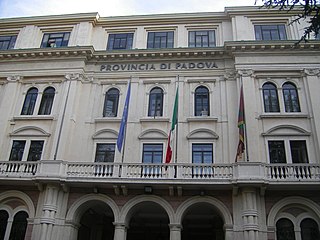
The Province of Padua is a province in the Veneto region of Italy. Its capital is the city of Padua.

Sottomarina is a small town on a peninsula which has the same name. It is a frazione of the comune of Chioggia, which is part of the Metropolitan City of Venice in the Veneto region in north-eastern Italy.

The Bacchiglione is a river that flows in Veneto, northern Italy. It rises in the Alps and empties about 90 miles (140 km) later into the Brenta River near Chioggia. It flows through and past a number of cities, including Vicenza and Padua. It acted for many centuries as a significant waterway up to Vicenza, above which it ceases to be navigable. It was connected in the 19th century to the Adige by a canal.

Battaglia Terme is a town and comune in the Veneto region of Italy, in the province of Padua.

The Nuova Mala del Brenta (NMB), also known as New Brenta Mafia, is a criminal organization based in the Veneto region of Italy. The group is believed to have emerged in the late 1990s as a successor to the original Mala del Brenta, which was active in the area during the 1970s and 1980s.

The Riviera del Brenta is an area of the Metropolitan City of Venice of particular tourist-cultural interest due to the great architectural heritage of the Venetian villas built between the 15th and 18th centuries by the nobles of the Venetian Republic along the river Brenta.

Villa Pisani at Stra refers to the monumental, late-Baroque rural palace located along the Brenta Canal at Via Doge Pisani 7 near the town of Stra, on the mainland of the Veneto, northern Italy. This villa is one of the largest examples of Villa Veneta located in the Riviera del Brenta, the canal linking Venice to Padua. The patrician Pisani family of Venice commissioned a number of villas, also known as Villa Pisani across the Venetian mainland. The villa and gardens now operate as a national museum, and the site sponsors art exhibitions.

Actv S.p.A. is a public company responsible for public transportation in Venice and Chioggia municipalities and for interurban bus services in province of Venice. ACTV is not responsible for Venice People Mover and waterbus routes between airport and the lagoon area. Connections by bus with Venice airport are managed by ACTV and by ATVO.

Camponogara is a town in the Metropolitan City of Venice, Veneto, Italy. It is west of SP13, not far from the nearby Brenta river. Economy is based on the production of wine, including Cabernet and Merlot, and manufacturing of shoes and leather products.

Fiesso d'Artico is a town in the Metropolitan City of Venice, Veneto, Italy. The town is connected by the SR11, and is part of the Riviera del Brenta.
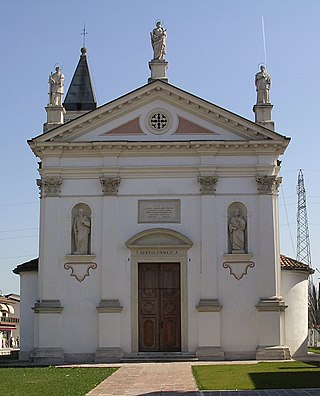
Fossò is a town and comune in the Metropolitan City of Venice, Veneto, Italy. It is west of SP13.
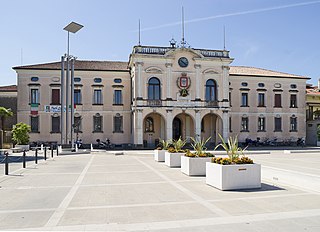
Mira is a comune (municipality) in the southern Veneto, northern Italy. It is part of the Metropolitan City of Venice and the 11th most populous comune of Veneto.

Vigonovo is a town in the Metropolitan City of Venice, Veneto, Italy. It is south of SR11.
The Via Annia was the Roman road in Venetia in north-eastern Italy. It run on the low plains of the lower River Po and of the lower Veneto and Friuli Venezia Giulia regions, an area which had many rivers and large marsh areas and bordered the coastal lagoons. It linked Atria to Aquileia, passing through Patavium. Then it got to the mainland coast of the Lagoon of Venice near today's Mestre and passed through Altinum. After this, it went through Iulia Concordia, which was further inland. It was paved only through the main towns. The rest was gravelled. It was six to eighteen metre wide. It played an important part in the Romanization of the region.
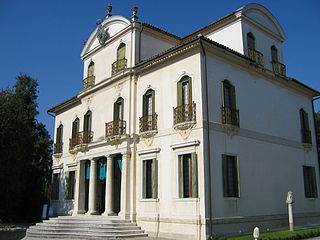
The Villa Widmann, also called Widmann-Rezzonico-Foscari, is a villa at the shores of the river Brenta located in the small town of Mira, between Venice and Padua.
Vetrego is a frazione of the comune of Mirano, Italy, Province of Venice, Region Veneto.
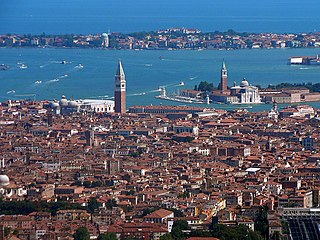
The Metropolitan City of Venice is a metropolitan city in the Veneto region, Italy, one of ten metropolitan cities in Italy. Its capital is the city of Venice. It replaced the Province of Venice in 2015 and includes the city of Venice and 43 other municipalities (comuni). It was first created by the reform of local authorities and then established by the Law 56/2014. The Metropolitan City of Venice is headed by the Metropolitan Mayor and by the Metropolitan Council. Since 15 June 2015, as new mayor of the capital city, Luigi Brugnaro is the first mayor of the metropolitan city.

The magistrato alle acque was a collective magistracy of the Republic of Venice, responsible for water management in the Venetian Lagoon. It comprised a series of boards of magistrates established in the early 16th century, and existed until the Fall of the Republic of Venice in 1797. Between 1907 and 2014, the body was revived by the Italian state, with responsibilities extending over the entire Veneto and the Province of Mantua.
Gronda lagunare is a term used to indicate the area of the Lagoon of Venice by its mainland shore. The term is derived from the fact that it receives the waters from the rivers and streams which flow into the lagoon from the drainage basin of the plain of the mainland by the lagoon. It is also reached by the tidal flows form he sea., it is meant to be a belt that forms a transition area between the open lagoon and the mainland.





















